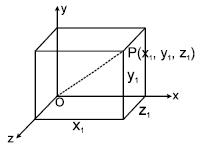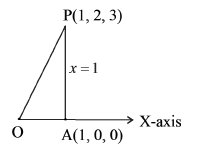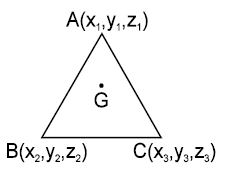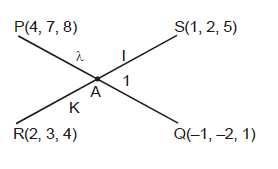1. COORDINATE OF A POINT IN SPACE
There are infinite number of points in space. We want to identify each and every point of space with the help of three mutually perpendicular coordinate axes OX, OY and OZ.
Three mutually perpendicular lines OX, OY, OZ are considered as the three axes.
The plane formed with the help of x and y axes is called x-y plane, similarly y & z axes form y-z plane and z and x axes form z – x plane.
Consider any point P in the space, Drop a perpendicular from that point to x -y plane, then the algebraic length of this perpendicular is considered as z-coordinate and from foot of the perpendicular drop perpendiculars to x and y axes. These algebraic lengths of perpendiculars are considered as y and x coordinates respectively.

2. VECTOR REPRESENTATION OF A POINT IN SPACE
If coordinate of a point P in space is (x, y, z) then the position vector of the point P with respect to the same origin is .
3. SIGNS OF CO-ORDINATES OF A POINT IN VARIOUS OCTANTS
|
Octant Coordinates |
I |
II |
III |
IV |
V |
VI |
VII |
VIII |
|
x |
+ |
– |
– |
+ |
+ |
– |
– |
+ |
|
y |
+ |
+ |
– |
– |
+ |
+ |
– |
– |
|
Z |
+ |
+ |
+ |
+ |
– |
– |
– |
– |
4. DISTANCE FORMULA
Distance between any two points (x1, y1, z1) and (x2, y2, z2) is given as
Vector method
We know that if position vector of two points A and B are given as and then
5. DISTANCE OF A POINT P FROM COORDINATE AXES
Let PA, PB and PC are distances of the point P(x, y, z) from the coordinate axes OX, OY and OZ respectively then
Illustration-1
Show that the points (0, 7, 10), (– 1, 6, 6) and (– 4, 9, 6) form a right angled isosceles triangle.
Solution
Let A (0, 7, 10), B (–1, 6, 6), C (– 4, 9, 6)
AB2 = (0 + 1)2 + (7 – 6)2 + (10 – 6)2 = 18
Similarly
Clearly AB2 +BC2 = AC2
Also AB = BC
Hence is right angled isosceles.
Illustration-2
Show by using distance formula that the points (4, 5, –5), (0, –11, 3) and (2, –3, –1) are collinear.
Solution
Let A(4, 5, -5), B (0, -11, 3), C (2, -3, -1)
BC + AC = AB
Hence points A, B, C are collinear and C lies between A and B.
Illustration-3
Find the locus of a point which moves such that the sum of its distances from points A(0, 0, –) and B(0, 0, ) is constant.
Solution
Let the variable point whose locus is required be P(x, y, z)
Given PA + PB = constant = 2a (say)
or,
This is the required locus.
Illustration-4
The point equidistant from the points A(a,0,0), B (0,b,0), C (0,0,c) and origin.
Solution
Let P (x, y, z) be the required point
OP2 = PA2
, similarly y =b/2, z= c/2
P(a/2, b/2, c/2)
Illustration-5
The distance of the point ( 1,2,3) from the x-axis is
Solution

OA = 1,
6. SECTION FORMULA
If point P divides the distance between the points in the ratio of m : n, then coordinates of P are given as

Mid point

7. CENTROID OF A TRIANGLE

8. INCENTRE OF TRIANGLE ABC
Where AB = c, BC = a, CA = b
9. CENTROID OF A TETRAHEDRON
A(x1, y1, z1) B(x2, y2, z2) C(x3, y3, z3) and DC(x4, y4, z4) are the vertices of a tetrahedron then coordinate of its centroid (G) is given as
Illustration-6
Show that the points A(2, 3, 4), B(–1, 2, –3) and C(–4, 1, –10) are collinear. Also find the ratio in which C divides AB.
Solution
Given A (2, 3, 4), B (–1, 2, –3), C (– 4, 1, –10).

Let C divide AB internally in the ratio k : 1, then
For this value of k,
Since k < 0, therefore k divides AB externally in the ratio 2 : 1 and points A, B, C are collinear.
Illustration-7
The vertices of a triangle are A(5, 4, 6), B(1, –1, 3) and C(4, 3, 2). The internal bisector of BAC meets BC in D. Find AD.
Solution

Since AD is the internal bisector of BAC
D divides BC internally in the ratio 5 : 3
or,
Illustration-8
If the points P, Q, R, S are (4, 7, 8), (– 1, – 2, 1), (2, 3, 4) and (1, 2, 5) respectively, show that PQ and RS intersect. Also find the point of intersection.
Solution
Let the lines PQ and RS intersect at point A.

Let A divide PQ in the ratio : 1, then
Let A divide RS in the ratio k : 1, then
From (1) and (2), we have,
From (3),
or
From (4),
or
Multiplying equation (6) by 2, and subtracting from equation (7), we get
– + k = 0 or, = k
Putting = k in equation (6), we get
or,
But , as the co-ordinates of P would then be underfined and in this case
PQ || RS, which is not true.
.
Clearly k = 1 satisfies eqn. (5).
Hence our assumption is correct
10. COLLINEAR POINTS
If the points are collinear points then
AB : BC = or or or
11. COORDINATE PLANE DIVIDES LINE SEGMENT
If A(x1, y1, z1) and B(x2, y2, z2) are two points then
i) yoz plane divides the line segment AB in the ratio
ii) zox plane divides the line segment AB in the ratio
iii) x o y plane divides the line segment AB in the ratio
iv) The internal angular bisector of angle A of triangle ABC intersect the opposite side BC in D and I is incentre of the triangle then
i) BD : DC = AB:AC ii) AI : ID = AB+AC : BC
12. LOCUS
i) The set of all points in the space satisfying given condition or a given property is called locus.
ii) If p(x, y, z) is any point in a Locus then the algebraic relation between x, y, z obtained by using geometrical condition is called the equation of the locus.
iii) The Locus of the point which is at a distance of k units from
XOY plane is |z| = k
YOZ plane is |x| = k
ZOX plane is |y| = k
iv) The Locus of the point which is equidistant from
a) XY- plane and YZ – plane is
b)YZ- plane and XZ – plane is
c) XZ- plane and XY – plane is
13. TRANSLATION OF AXES
i) The transformation that obtained by shifting origin to some another point without changing the direction of axes is called Translation of axes.
ii) If we shift the origin to the point (h,k,l) without changing the directions of the coordinate axes and (x,y,z) and (X,Y,Z) are the coordinates of the point P with respect to the old axes, new axes
respectively, then
x = X + h, y = Y + k, z = Z + l
Illustration-9
The line passing through the points A (5,1,a) and B (3,b,1) crosses the yz – plane at the point
Then the values of a, b are
Solution
YZ plane divides in the ratio =
Illustration-10
The ratio in which the line joining the points A ( -3,4,8) and B( 5,-6,4) is divided by xoy plane and the point of intersection of the line with the plane.
Solution
Let P divides AB in the ratio
P is in xoy plane
plane divides AB externally in the ratio 2:1, Point of intersection = ( 13,-16,0)
Illustration-11
If the vertices of a triangle are A( 3,2,0) B(5,3,2) C( -9,6,-3) , the internal bisector of angle A meets BC in D, then co-ordinates of D are
Solution
We know that
Illustration-12
What is the locus of the equation
Solution
Sum of positive numbers not equal to zero
Locus is an empty set








